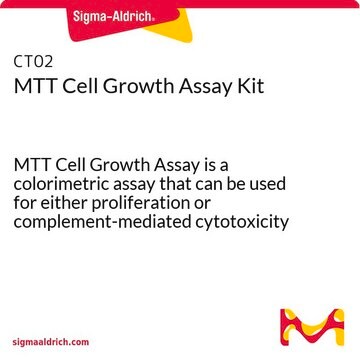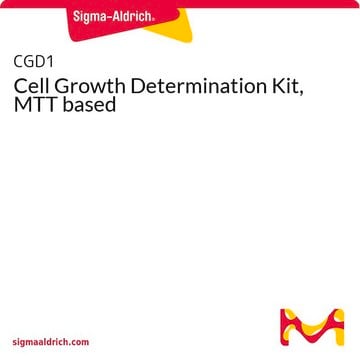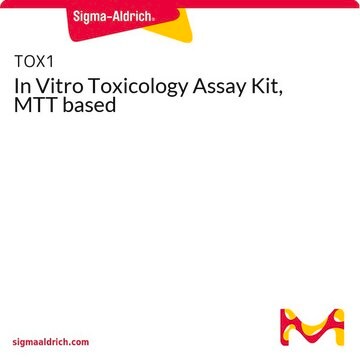11465015001
Roche
Cell Proliferation Kit II (XTT)
liquid, pkg of 1 kit, suitable for cell analysis, suitable for tissue culture
Synonim(y):
xtt
About This Item
Polecane produkty
Postać
liquid
Poziom jakości
zastosowanie
sufficient for ≤2,500 tests
opakowanie
pkg of 1 kit
producent / nazwa handlowa
Roche
warunki przechowywania
protect from light
metody
tissue culture: suitable
λmaks.
450-500 nm
Zastosowanie
cell analysis
detection
metoda wykrywania
colorimetric
temp. przechowywania
−20°C
Powiązane kategorie
Opis ogólny
Colorimetric assays analyze the number of viable cells by the cleavage of tetrazolium salts added to the culture medium. This technique requires neither washing nor harvesting of cells, and the complete assay, from microculture to data analysis by an ELISA reader, is performed in the same microplate.
More recently, the tetrazolium salt XTT was described. In contrast to MTT, the cleavage product of XTT is soluble in water; therefore, a solubilization step is not required. The tetrazolium salt XTT is cleaved to formazan by a complex cellular mechanism. This bioreduction occurs in viable cells only, and is related to NAD(P)H production through glycolysis. Therefore, the amount of formazan dye formed directly correlates to the number of metabolically active cells in the culture.
Zastosowanie
- Measurement of cell proliferation in response to growth factors, cytokines, mitogens, and nutrients.
- Analysis of cytotoxic and cytostatic compounds, such as anti-cancer drugs and other pharmaceutical compounds.
- Assessment of growth-inhibitory antibodies and physiological mediators that inhibit cell growth.
- Testing of biocompatibility of various scaffolds, employed in bone tissue engineering, for bone cell growth.
- cell viability assay.
Cechy i korzyści
- Safe and easy: Eliminate radioactive isotopes, washing steps, and additional reagents.
- Accurate: The absorbance obtained strongly correlates to the cell number.
- Sensitive: Detect low cell numbers.
- Fast: Process a large number of samples using a multi-well ELISA reader.
Opakowanie
Zasada
Cell proliferation and viability assays are of particular importance for routine applications in cell biology. Tetrazolium salts (e.g., MTT, XTT, WST-1) are particularly useful for this type of analysis. Tetrazolium salts are cleaved to formazan by the succinate-tetrazolium reductase system (EC 1.3.99.1) which belongs to the respiratory chain of the mitochondria, and is only active in metabolically intact cells.
Uwaga dotycząca przygotowania
Thaw XTT labeling reagent and electron-coupling reagent, respectively in a water bath at 37 °C. Mix each vial thoroughly to obtain a clear solution.
XTT labeling mixture
To perform a cell proliferation assay (XTT) with one microplate (96 wells) mix 5 ml XTT labeling reagent with 0.1 ml electron coupling reagent.
Note: To obtain reliable results thaw and mix XTT labeling reagent and electron coupling reagent immediately before use.
Working instruction
Cells are grown in microplates (tissue culture grade, 96 wells, flat bottom) in a final volume of 100 μl culture medium per well, according to the media needs of the cells in a humidified atmosphere (e.g., 37 °C, 6.5% CO2).
The incubation period of the cell cultures depends on the particular experimental approach and on the cell line, used for the assay. For most experimental setups, the incubation of cells for 24 to 96 hours is appropriate.
After the incubation period, add to each well 50 μl of the XTT labeling mixture, prepared as described above (final XTT concentration 0.3 mg/ml).
Incubate the microplate for 4 to 24 hours in a humidified atmosphere (e.g., 37 °C, 6.5% CO2).
Note: The incubation time varies with the individual experimental setup (e.g., cell type and cell concentration, used). Therefore, we recommend to measure the absorption as described at different time points after addition of XTT labeling mixture (e.g., 4, 6, 8, 12, and 18 hours) using one and the same microplate to determine the optimal incubation period for the particular experimental setup.
Storage conditions (working solution): Thaw reagents immediately before use. It is recommended to prepare appropriate aliquots [5 ml XTT labeling reagent and 0.1 ml electron coupling reagent are required for the performance of the assay with one microplate (96 wells)]
Note: Avoid repeated thawing and freezing.
Inne uwagi
Tylko elementy zestawu
- XTT Labeling Reagent
- Electron-coupling Reagent
produkt powiązany
Kod klasy składowania
12 - Non Combustible Liquids
Klasa zagrożenia wodnego (WGK)
nwg
Temperatura zapłonu (°F)
does not flash
Temperatura zapłonu (°C)
does not flash
Certyfikaty analizy (CoA)
Poszukaj Certyfikaty analizy (CoA), wpisując numer partii/serii produktów. Numery serii i partii można znaleźć na etykiecie produktu po słowach „seria” lub „partia”.
Masz już ten produkt?
Dokumenty związane z niedawno zakupionymi produktami zostały zamieszczone w Bibliotece dokumentów.
Klienci oglądali również te produkty
Produkty
Cell based assays for cell proliferation (BrdU, MTT, WST1), cell viability and cytotoxicity experiments for applications in cancer, neuroscience and stem cell research.
Testy komórkowe do proliferacji komórek (BrdU, MTT, WST1), żywotności komórek i eksperymentów cytotoksyczności do zastosowań w badaniach nad rakiem, neuronauką i komórkami macierzystymi.
Protokoły
Perform colorimetric assays for nonradioactive quantification of cellular proliferation, viability, and cytotoxicity for adherent or suspension cells cultured in 96-well microplates.
Przeprowadzanie testów kolorymetrycznych w celu nieradioaktywnej kwantyfikacji proliferacji, żywotności i cytotoksyczności komórek przylegających lub zawiesinowych hodowanych w 96-dołkowych mikropłytkach.
Nasz zespół naukowców ma doświadczenie we wszystkich obszarach badań, w tym w naukach przyrodniczych, materiałoznawstwie, syntezie chemicznej, chromatografii, analityce i wielu innych dziedzinach.
Skontaktuj się z zespołem ds. pomocy technicznej












